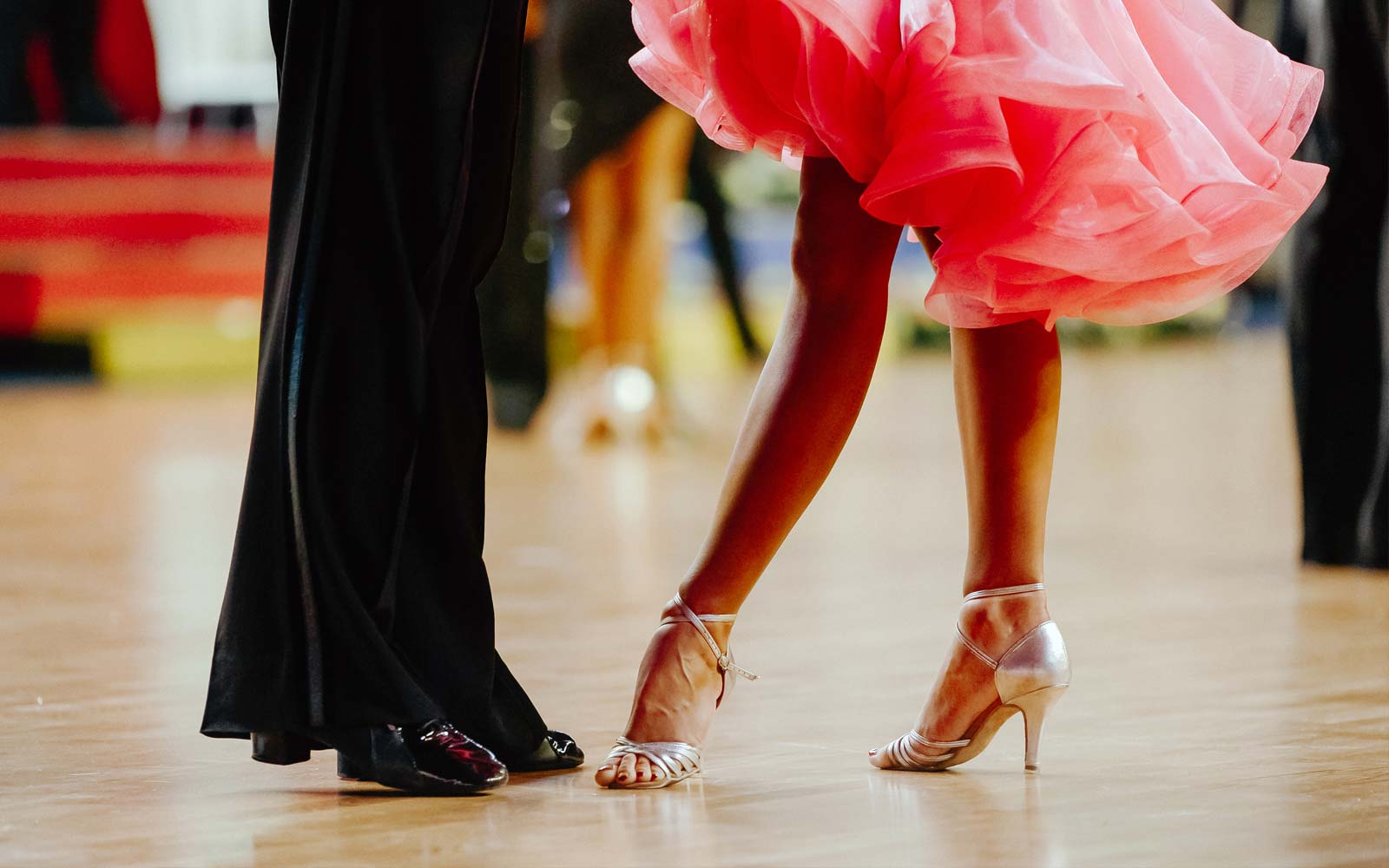Ballroom dance is generally defined as “two people moving together to music.” Musicality is essential, and we often talk about the technical details required for a couple to move together in perfect harmony. But what often doesn’t get talked about is the “two people” part of the equation.
A ballroom dance partnership is made up of a team of two. The partnership might last for just one dance, or it might be a life partner that you dance with. But anytime you have two people, there will be challenges. Differences in styles. Differences in how you communicate. Different goals and objectives. Plus, in ballroom dancing, we typically have a partnership made up of two genders, adding a whole additional dimension. Men and women think differently. It’s often hard for even married couples to agree on the same thing, so that challenge extends to the dance partnership as well.
There are five common mistakes people make in dance partnerships. Let’s take a look at them. See if you can identify any that you might be making.
You vs Us
One of the biggest problems we see in dance partnerships is a simple case of using the wrong words. When things go wrong, it’s pretty hard for most people to immediately see themselves as the source of the problem. So the words come out, often without thinking: “you made this mistake” or “you didn’t do this right.” Hey, it’s a partnership. Even if it was the partner’s fault, you don’t gain anything by blaming the other party.
It’s not always the man doing this, either. Just as often I’ve seen ladies blaming their partner every time he makes a mistake. This corrodes the man’s confidence and often leads to the gentlemen deciding that dance isn’t for them. That’s a real shame, as it’s hard enough to get men onto the dance floor to start with!
Instead, make a point of including both of you in the issue. “That didn’t work. How can we make it better?” or “We need to try that again.” After all, how much does it really matter who was responsible? If there’s a problem, focus on fixing it together. You won’t improve the partnership by putting the blame on the other person when things go wrong.
I’ve seen some remarkable partnerships where an advanced dancer, sometimes even a Championship-level competitor, would take a beginner under his or her wing and patiently work with them to bring them up to speed. Imagine how well that would go if they were constantly blaming their partner for doing things wrong?
Failure to discuss problems
Another common mistake is when a couple never talks about what is happening in the practice session. I’ve seen this countless times, usually with married couples. I’ve witnessed couples practicing for hours without ever talking about a single thing that’s going on in their practice session. How exactly can you improve if there’s zero communication?
It’s possible that this situation comes about because of problems like the first one, as a way of heading off the blame game. But it’s not a solution at all, because you won’t be able to improve if you can’t identify what’s working or not working and then seek to fix those issues.
Make a point of clarifying where you are uncomfortable, or where you feel something isn’t achieving what you want. Without blaming either party, try to identify through honest discussion why something isn’t working. Is it a problem with balance? If so, what could be causing the balance issue? What steps can you take to improve the balance of the partnership? Only through discussion will you be able to resolve things.
Now, speaking from experience, it can be challenging to communicate this thoroughly with a partner who is already your life partner. Familiarity tends to break down some of the natural respect that exists between people who aren’t romantically involved. I will sometimes work with female professionals for the specific reason that we can openly communicate in ways that can’t be achieved when dancing with my wife. The ego is completely left behind in these cases. I feel comfortable questioning specific details of my own performance openly, without fear that something I did or didn’t will be used against me in a disagreement some time down the road. That may be an option for you as well.
Instead, make a point of including both of you in the issue. “That didn’t work. How can we make it better?” or “We need to try that again.”
Passive Agressive behavior
A typical example of Passive Agressive behavior is when someone pretends to “fix” a problem by over-compensating. It happens a lot more than most people think. A lady might feel that her partner is gripping her hand too tightly, so he responds by not touching her at all. Or the gent feels that his partner’s connection might be better a little further back, so she responds by staying way back behind him, where it makes no sense at all.
As teachers we see this quite often in group classes, probably because it’s a quiet way to “argue” in a group environment. It’s destructive and doesn’t help to resolve issues. However, I do believe it’s closely linked to the first problem, that of blaming the partner. When one party feels that they are being blamed for something, the ego kicks in (men and women both have egos), and to avoid a verbal confrontation, Passive Agressive behavior is often their chosen response.
If you find yourself in this situation, try to step back from your emotional response. Take the high road. If your partner does have a habit of blaming you, step away for a few seconds and let your mind calm down before you resume your practice, so that you can do so in the right frame of mind. Discuss the issue. To avoid being the target of blame, share how it makes you feel instead of applying a Passive Agressive response. Suggest that since you are a partnership, you would prefer if you talked about problems from a neutral point of view instead of blaming the other person.
Failing to have a goal
If you’re a social dancer, you may feel that there’s no need to set a goal for your dancing. But there’s always a goal! Having a goal ensures that you have something ahead of you that you are reaching to achieve. It might be learning a group of figures. Becoming better at putting figures together so that you can dance around the room without using the same figures too many times. Improving your musicality. Being able to follow a beginner’s inexperienced leads. There are lots of small and major goals available for any social dancer. If you’re a competitor, then goals are pretty easy overall.
But don’t stop with the big picture goals. Take your goal setting to each specific practice. When Wendy and I were actively competing, we had a coach who would ask us to focus on one detail at a time during our competitor practices, which involved rounds. We would do one round with the entire focus on musicality. The goal was to ignore everything else, forgetting about technical details like footwork, and just think about musicality. Then for the next round the entire focus might be on connection. And for another round the entire focus might be on how we are breathing.
When doing technical practices, the same options apply. Plan ahead whether the practice will be to perfect a step patterns, musicality, connection, use of the head, use of energy, arm styling, or something else. By assigning these goals to your practice sessions, you’ll feel that you’ve accomplished something when you’ve finished.
Forgetting the basics
As a dance teacher, one of the things I find increasingly frustrating is today’s lack of respect for basic technique. We live in a world that is used to seeking instant results. People want to shortcut their way to the top. They want all the benefits without putting in the work. You can see this happening in every sphere of life! Far too many ballroom dancers decide that the basic figures are too simple or too boring or require too much time. Then, long before they are ready, they advance to “open” choreography.
When I attend dance camps with the world’s top teachers, who have a room full (or, these days a Zoom full) of professionals and high-level competitors, what do they always focus on? Basic principles! The basics are critical. Without a solid understanding of the basics, you will never become a great dancer.
I love to watch top-level competitions and showcase dancing on digital platforms like YouTube. What I’ve noticed is that there’s a massive difference in skill between the “amateur” competitors from back in 2007 or even 2012 as compared to watching amateur competitors from the most recent events. The latest competitions are almost painful to watch, because the quality has declined so dramatically. Many of the couples in these recent events should not be attempting open figures. They aren’t ready yet.
Take a look for yourself in the videos below:
In contrast, watch what the top professional couples do during their presentation dance or honour dance. Typically they will include many basic figures in their choreography. They show just how beautiful those figures look when danced properly.
Never lose sight of the basics. At every skill level, these are the foundational elements that empower you to be a great dancer.
Take a moment to reflect honestly on your own partnerships. Are you making any of these mistakes? If so, make a point of cleaning up any areas that need improvement in how you work with your partner(s), and you’ll find your dancing will improve as a result.
You may also like: The Beauty of Basic Ballroom Steps














